Advertisements
Advertisements
प्रश्न
Two capacitors of capacitance 20⋅0 pF and 50⋅0 pF are connected in series with a 6⋅00 V battery. Find (a) the potential difference across each capacitor and (b) the energy stored in each capacitor.
उत्तर
Given :
`C_1 = 20.0 "pF"`
`C_2 = 50.0 "pF"`
When the capacitors are connected in series, their equivalent capacitance is given by `C_(eq) = (C_1C_2)/(C_1+C_2)`
∴ Equivalent capacitance,`C_(eq) = ((50 xx 10^-12) xx (20 xx 10^-12))/((50 xx 10^-12)+(20 xx 10^-12))` = `1.428 xx 10^-11 "F"`
(a) The charge on both capacitors is equal as they are connected in series. It is given by
`q = C_(eq) xx V`
⇒ `q = (1.428 xx 10^-11) xx 6.0 "C"`
Now ,
`V_1 = q/C_1 = ((1.428 xx 10^-11) xx 6.0 "C")/((20 xx 10^-12))`
⇒ `V_1 = 4.29 "V"`
and
`V_2 = (6.00 - 4.29) V = 1.71 "V"`
(b) The energies in the capacitors are given by
`E_1 = q^2/(2C_1)`
= `[(1.428 xx 10^-11) xx 6.0]^2` `xx 1/(2 xx 20 xx 10^-12)`
= `184 "pJ"`
and
`E_2 = q^2/(2C_1)`
= `[(1.428 xx 10^-11) xx 6.0]^2` `xx 1/(2 xx 50 xx 10^-12)`
= `73.5 "pJ"`
APPEARS IN
संबंधित प्रश्न
Distinguish between Conductors and Insulators.
Draw a labelled diagram of Van de Graaff generator. State its working principle to show how by introducing a small charged sphere into a larger sphere, a large amount of charge can be transferred to the outer sphere. State the use of this machine and also point out its limitations.
The potential difference applied across a given resistor is altered so that the heat produced per second increases by a factor of 9. By what factor does the applied potential difference change?
In the figure shown, an ammeter A and a resistor of 4 Ω are connected to the terminals of the source. The emf of the source is 12 V having an internal resistance of 2 Ω. Calculate the voltmeter and ammeter readings.
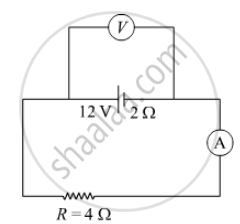
A metal rod of square cross-sectional area A having length l has current I flowing through it when a potential difference of V volt is applied across its ends (figure I). Now the rod is cut parallel to its length into two identical pieces and joined as shown in figure II. What potential difference must be maintained across the length of 2l. so that the current in the rod is still I?

In the circuit diagram given below, AB is a uniform wire of resistance 15 Ω and length 1 m. It is connected to a cell E1 of emf 2V and negligible internal resistance and a resistance R. The balance point with another cell E2 of emf 75 mV is found at 30 cm from end A. Calculate the value of R.
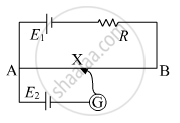
Draw a schematic diagram and explain the working of Van de Graff generator device.
A test charge ‘q’ is moved without acceleration from A to C along the path from A to B and then from B to C in electric field E as shown in the figure. (i) Calculate the potential difference between A and C. (ii) At which point (of the two) is the electric potential more and why?
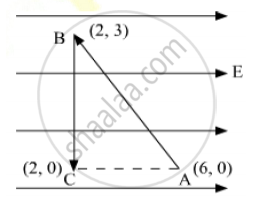
The figure shows a plot of three curves a, b, c, showing the variation of photocurrent vs collector plate potential for three different intensities I1, I2and I3 having frequencies v1, v2 and v3 respectively incident of a photosensitive surface.
Point out the two curves for which the incident radiations have same frequency but different intensities.
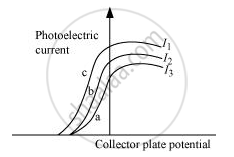
A charge of `+2.0 xx 10^-8 C` is placed on the positive plate and a charge of `-1.0 xx 10^-8 C` on the negative plate of a parallel-plate capacitor of capacitance `1.2 xx 10^-3 "uF"` . Calculate the potential difference developed between the plates.
The capacitance between the adjacent plates shown in figure is 50 nF. A charge of 1⋅0 µC is placed on the middle plate. (a) What will be the charge on the outer surface of the upper plate? (b) Find the potential difference developed between the upper and the middle plates.
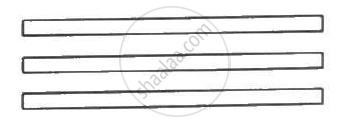
The capacitance between the adjacent plates shown in the figure is 50 nF. A charge of 1.0µC is placed on the middle plate. If 1.0 µC is placed on the upper plate instead of the middle, what will be the potential difference between (a) the upper and the middle plates and (b) the middle and the lower plates?
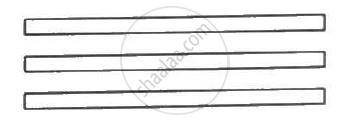
Answer the following question:
Find the expression for the resistivity of a material.
What will be the potential difference in the circuit when direct current is passed through the circuit?
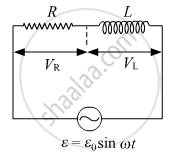
If a positive charge moves in the direction of the electric field ______.
Two metal pieces having a potential difference of 800 V are 0.02 m apart horizontally. A particle of mass 1.96 × 10–15 kg is suspended in equilibrium between the plates. If e is the elementary charge, then charge on the particle is ______.
Assertion: Electric potential and electric potential energy are different quantities.
Reason: For a system of positive test charge and point charge electric potential energy = electric potential.
An α-particle and a proton are accelerate at same potential difference from rest. What will be the ratio of their final velocity?
Work done in moving a unit positive charge through a distance of x meter on an equipotential surface is:-
